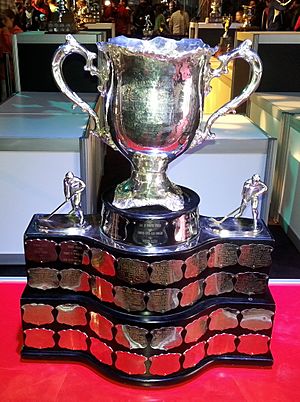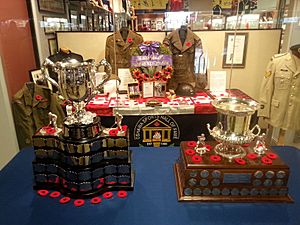Memorial Cup facts for kids
Quick facts for kids Memorial Cup |
|
|---|---|

The Memorial Cup at the 2015 tournament
|
|
| Sport | Ice hockey |
| Given for | Canadian Hockey League champion |
| History | |
| First award | 1919 |
| First winner | University of Toronto Schools |
| Most wins | Toronto Marlboros (7) |
| Most recent | London Knights (OHL) |
The Memorial Cup (French: Coupe Memorial) is a very important ice hockey championship in Canada. It is the national championship for the Canadian Hockey League (CHL). The CHL is a group of three major junior ice hockey leagues in Canada and parts of the United States.
This championship is a four-team round-robin tournament. It includes the champions from the Ontario Hockey League (OHL), the Quebec Maritimes Junior Hockey League (QMJHL), and the Western Hockey League (WHL). A fourth team, called the "host team," also plays. This host team changes each year between the three leagues.
The Memorial Cup trophy was created by Captain James T. Sutherland. He wanted to honor all the soldiers who died serving Canada during World War I. Later, in 2010, the cup was rededicated. Now, it honors all Canadian soldiers who have died fighting for their country in any conflict.
The trophy was first called the OHA Memorial Cup. The Ontario Hockey Association (OHA) donated it in 1919. It was given to the best junior ice hockey team in Canada. Until 1971, many Junior A teams across the country could compete for it. They played through many league, provincial, and regional playoffs. The final game was an East-versus-West championship.
The current four-team tournament format started in 1972. This was after the Canadian Amateur Hockey Association divided junior hockey into two levels. The Memorial Cup became the championship for the top level, called Major Junior.
Many people say the Memorial Cup is one of the hardest championships to win in hockey. This is because there are so many teams in the CHL. Only the very best teams make it to the tournament. Also, players can only play at the major junior level for a limited time.
Contents
History of the Memorial Cup
How the Memorial Cup Started
Captain Sutherland was serving overseas during World War I. He was also the President of the Ontario Hockey Association (OHA). He had an idea to create a trophy. This trophy would honor all the young Canadian hockey players who died in battle. It would be awarded to the best junior hockey team in Canada.
The OHA held its yearly meeting in 1918. Everyone agreed that a special memorial should be made. It would remember the OHA members who had died in the war. A newspaper article from December 9, 1918, mentioned Captain Sutherland's idea. He spoke about the great work done by Canadian soldiers in France. He suggested a memorial for hockey players who had fallen.
Another article from 1939 explained more. It said Captain Sutherland thought of the cup while he was overseas in World War I. He was the OHA President at the time. He wrote suggesting the trophy to remember the boys killed in the war. He was especially devoted to his friend, Alan "Scotty" Davidson, who died in 1915. Many other hockey players also died in the war. This included Captain George T. Richardson, who died in France in 1916. Both Davidson and Richardson are now in the Hockey Hall of Fame.
Early Tournament Formats
The Memorial Cup started as an East-versus-West competition. The champions from Eastern Canada, who won the George Richardson Memorial Trophy, played against the champions from Western Canada, who won the Abbott Cup.
From 1919 to 1928, the Memorial Cup Final was decided by the total goals scored over two games. A champion from Eastern Canada played a champion from Western Canada. These teams were chosen through many playoff games.
In 1929, the Memorial Cup Final changed. It became a best-of-three series. This meant a team had to win two games to become champion.
In 1934, junior hockey teams were divided even more. There were Junior 'A' and Junior 'B' teams. The Memorial Cup became the championship trophy for Junior 'A' teams. The Sutherland Cup was created for Junior 'B' teams. By 1937, the Memorial Cup was a best-of-five series. Then, in 1943, it became a best-of-seven series.
For the 1970–1971 season, the Junior 'A' level was split again. It became the Major Junior level and a second-tier level (now called Junior 'A'). The Memorial Cup became the championship for the Major Junior level. Other trophies, like the Manitoba Centennial Trophy and later the Royal Bank Cup, were for the second-tier championship.
Modern Tournament Format
In 1972, the Memorial Cup tournament changed to include three teams. These were the champions of the three leagues in the Canadian Hockey League. They were the winners of the Ed Chynoweth Cup (WHL), the J. Ross Robertson Cup (OHL), and the President's Cup (QMJHL) (QMJHL).
From 1972 to 1973, these three teams played a single round-robin. Each team played two games. The top two teams then played in a single championship game. A semi-final game was added in 1974. In 1977, the tournament expanded to a double round-robin. Each team played four games, and there was no semi-final. The tournament was held in a different city each year, chosen by one of the three leagues.
The 1983 Memorial Cup tournament added a fourth team. This was the team hosting the event. This change was made to get more people to watch the games. The first tournament with this new format was in Portland, Oregon. It was the first time an American city hosted the Memorial Cup. The host team, the Portland Winter Hawks, also won the Cup that year. They were the first American team and the first host team to win it.
In this four-team format, all teams play a single round-robin (three games each). If two teams are tied for third place, they play an extra tie-breaker game. Then, a semi-final game is played between the second and third-place teams. The winner of the semi-final plays the first-place team in the final. This format is still used today. The honor of hosting the tournament rotates among the CHL's three leagues.
If the host team also wins its own league championship, then the spot for that league's champion goes to the league's runner-up. This happened in 2006. The Quebec Remparts lost to the Moncton Wildcats in the QMJHL Finals. But since Moncton was hosting the Memorial Cup, Quebec got to play in the tournament. The Remparts then went on to win the Memorial Cup that season. This was the first time a team won the tournament without being the host or their league's champion.
Trophy Mishaps and Cancellations
The Memorial Cup trophy has had a couple of accidents. At the 2008 tournament, a replica trophy broke. This happened when captain Chris Bruton of the winning Spokane Chiefs tried to pass it to a teammate. The crowd reacted when the replica cup fell apart. The Chiefs then took the trophy apart and shared it among themselves. In 2012, defenceman Dillon Donnelly of the Shawinigan Cataractes accidentally dropped the trophy. It was significantly damaged. The official cup is usually kept safe at the Hockey Hall of Fame in Toronto, Ontario, Canada.
Because of the COVID-19 pandemic, the tournaments in 2020 and 2021 were cancelled. The 2020 tournament was supposed to be in Kelowna. The OHL was going to host the 2021 tournament. These cancellations happened because of rules in different provinces. The QMJHL was the only league in the CHL to name a champion during the 2020–21 season. The Memorial Cup tournament started again in 2022.
Memorial Cup Champions

You can find a full list of winners here:
Memorial Cup Awards
Since 1972, the Memorial Cup committee has given out special awards for players in the tournament. There are now five awards given out every year.
| Award | Description | Founded |
|---|---|---|
| Stafford Smythe Memorial Trophy | Given to the most valuable player (MVP) of the tournament | 1972 |
| George Parsons Trophy | Given to the player who shows the best sportsmanship | 1974 |
| Hap Emms Memorial Trophy | Given to the best goaltender (goalie) | 1975 |
| Ed Chynoweth Trophy | Given to the player who scores the most points (goals + assists) | 1996 |
| Memorial Cup All-Star Team | A team made up of the best players at each position | 1975 |

